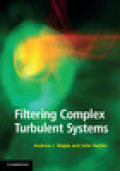
The authors develop a systematic applied mathematics perspective on the problems associated with filtering complex turbulent systems. The authors developa systematic applied mathematics perspective on the problems associated with filtering complex turbulent systems. The book contains background material from filtering, turbulence theory and numerical analysis, making it suitable for graduate courses as well as for researchers in a range of disciplines where applied mathematics is required. The authors develop a systematic applied mathematics perspective on the problems associated with filtering complex turbulent systems. The book contains background material from filtering, turbulence theory and numerical analysis, making it suitable for graduate courses as well as for researchers in a range of disciplines where applied mathematics is required. Many natural phenomena ranging from climate through to biology are described by complex dynamical systems. Getting information about these phenomena involves filtering noisy data and prediction based on incomplete information (complicated by the sheer number of parameters involved), and often we need to do this in real time, for example for weather forecasting or pollution control. All this is further complicated by the sheer number of parameters involved leading to further problems associated with the 'curse of dimensionality' and the 'curse of small ensemble size'. The authors develop, for the first time in bookform, a systematic perspective on all these issues from the standpoint of applied mathematics. The book contains enough background material from filtering,turbulence theory and numerical analysis to make the presentation self-contained and suitable for graduate courses as well as for researchers in a range ofdisciplines where applied mathematics is required to enlighten observations and models. INDICE: Preface; 1. Introduction and overview: mathematical strategies forfiltering turbulent systems; Part I. Fundamentals: 2. Filtering a stochastic complex scalar: the prototype test problem; 3. The Kalman filter for vector systems: reduced filters and a three-dimensional toy model; 4. Continuous and discrete Fourier series and numerical discretization; Part II. Mathematical Guidelines for Filtering Turbulent Signals: 5. Stochastic models for turbulence; 6. Filtering turbulent signals: plentiful observations; 7. Filtering turbulent signals: regularly spaced sparse observations; 8. Filtering linear stochastic PDE models with instability and model error; Part III. Filtering Turbulent Nonlinear Dynamical Systems: 9. Strategies for filtering nonlinear systems; 10. Filtering prototype nonlinear slow-fast systems; 11. Filtering turbulent nonlinear dynamical systems by finite ensemble methods; 12. Filtering turbulent nonlinear dynamical systems by linear stochastic models; 13. Stochastic parameterized extended Kalman filter for filtering turbulent signal with model error; 14. Filtering turbulent tracers from partial observations: an exactly solvable test model; 15. The search for efficient skilful particle filters for high dimensional turbulent dynamical systems; References; Index.
- ISBN: 978-1-107-01666-8
- Editorial: Cambridge University
- Encuadernacion: Cartoné
- Páginas: 368
- Fecha Publicación: 23/02/2012
- Nº Volúmenes: 1
- Idioma: Inglés
